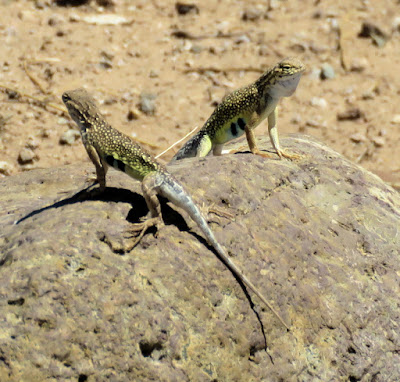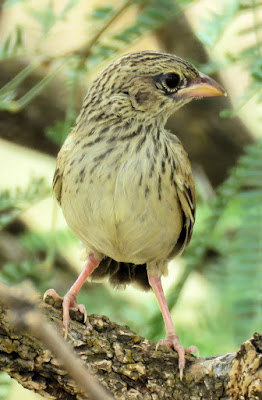Here is collection of images showing some of the birds – bugs – and critters we have encountered here in south east Arizona. They are all quite fascinating. We are not very good entomologists but we tried to be as accurate as we could with all of the information. Out good friend Rodger Shoemake helped us with many of the identifications and associated information – thanks Rodger
This Western Kingbird with a lunch snack seems appropriate to start the blog. We were out looking for birds one afternoon and in a 4 ½ mile stretch of farm roads we counted 115 Kingbirds. There are a couple of different species but they were predominantly Western Kingbirds. We will show the type of bug that the Kingbird has in a later image. Shortly after taking this photo he swallowed the bug whole.
Here are two lizards on a large rock that we saw out in Las Cienegas, a grassland area where we like to go birding and just exploring around. It was neat to see the two lizards running around on the rock. Not sure what kind of lizards these might be, there are lots of lizards around.
This is a small lizard maybe only an inch and a half long. There are a bunch of these little guys all around. It must be a great hatch year for lizards.
Around here there are lots and lots of doves. This group of doves posed quite nicely. The one with the white border on the wing is called a White-winged Dove, appropriately named. They are very common here. We mostly see White-winged and Mourning Doves and occasionally a Eurasian-collared Dove. We have also seen Common Ground Doves so there is quite a variety of species around here.
Here is a Horned Lizard also known as horny toad or horn toads that we see around here quite frequently. When you look at them close up they appear rather fierce. When a horned lizard feels threatened by a predator, its final defense response is to shoot blood from these flooded sinuses and out its eye sockets. As a result, the predator is often frightened and flees. We certainly would seeing that display.
Here is another horned lizard. It is actually quite small as seen in the next picture. The previous full sized horned lizard is about 5 inches long.
I kept placing my pocket knife close to the lizard to get a size perspective and the lizard would scurry off a short distance. The knife is about 3 ¼ inches in length so you can see the lizard is quite small, a very young one.
We ate lunch out in Sulphur Springs Valley one day in Elfrida at a restaurant called Kountry Kafe. Because of covid-19 they have set up a tent and have outside seating only. This small brown praying mantis joined us for lunch. He was not so much interested in our lunch as he was in several flies that were nearby. At various times he got close to one and you could tell by his movements he got excited. Unfortunately we never did see him catch one. He was very entertaining to watch.
This is a Mesquite Leaf-footed Bug. They are often quite large and fly around kind of slow and clumsily. They are not dangerous to humans they just look menacing. This is the bug that the Western Kingbird had in his beak in the first image.
Here is a link to a brief You Tube video of one of these bugs that we made showing one walking across a hedge. It is fascinating to watch them move. - https://www.youtube.com/watch?v=On_EdVgr9Ys
You can tell this is a millipede because it has two pairs of legs for each segmented section. It must take a lot of practice to keep all those legs under control and going the right direction at the right time. After a rain early in the year there we saw more than 45 millipedes on a walk around.
There are some numbers of tarantulas around here. They don’t bother anything much. The people who live here talk about who saw the biggest and did you see that one last night etc.
Here is a walking stick which is a neat little critter. It is maybe 3 inches long. It was in the middle of a walking trail and we stopped to watch it and make sure it got across before someone stepped on it.
This is a red velvet mite. It is really small maybe the size of a pencil eraser. We were surprised at how red it was, certainly did not have any camouflage for this environment.
This red, spiny covered caterpillar we found while on a walk. It was munching on some dead leaves. It is the caterpillar form of the Pipevine Swallowtail butterfly. They are a very common butterfly around here.
This image shows the Pipevine Swallowtail. This particular specimen is much worn and the markings are not very bright and colorful. It certainly does not hold any resemblance to the caterpillar form.
Just to interject a bird. This is a Roadrunner. We see them quite often and have shown images of them in previous blogs. Here it is hiding under a bush. It was about 100 degrees and the roadrunner is panting. There is quite remarkable coloration on the head.
This caterpillar we found along the side walk. He was moving somewhere and seemed to be in a hurry. After doing some research we determined it was the caterpillar form of the Western Tiger Swallowtail.
This is the Western tiger Swallowtail that will be the result from the caterpillar in the previous slide. Butterflies sure go through a quite a transformation. We borrowed this image to show the butterfly. Though we have seen the caterpillar we have not yet seen the butterfly here.
This is a Cooper’s hawk with an afternoon snack. It landed on the roof top across the way and consumed part of its snack before heading off. There was a Cooper’s nest in the south end of the area and we have seen both the adults and juveniles.
Here is the last image. It is a mystery bird and if anyone knows what it is we would appreciate the identification. We saw in August in Las Cienegas, an open grassland area. We had seen lots of different sparrows here over the summer but cannot pinpoint this juvenile. Perhaps it is a Cassin’s Sparrow. Some have thought it might be a Vesper Sparrow but they really are not here in the summer, they are winter sparrows here but then who knows.
We hope you enjoyed this brief look at some bugs – birds – and critters. There are lots of all three types around here and it is fun getting out and looking for them.
Please let us know if you have any questions or comments. All the best – George & Deanna




















What a menagerie! Thanks for sending such great photos.
ReplyDeleteHope all is well.
Nancy